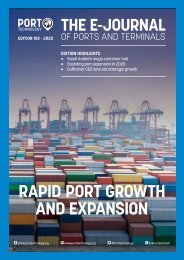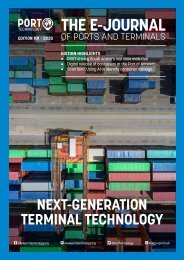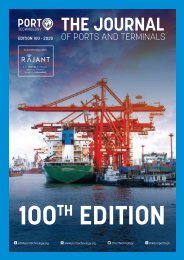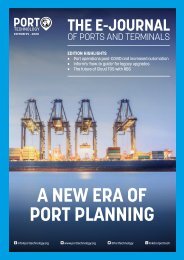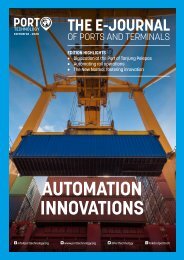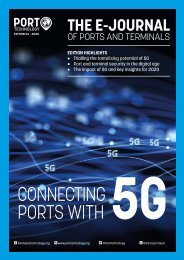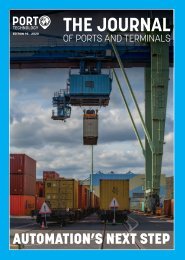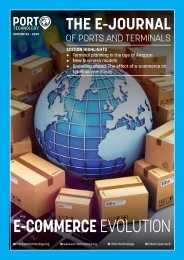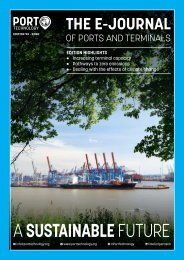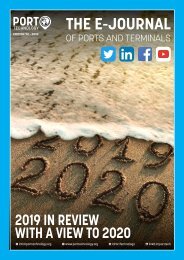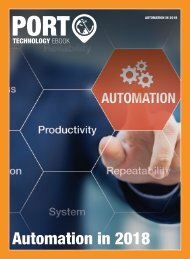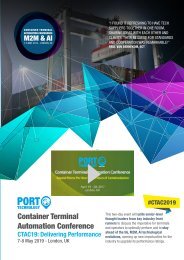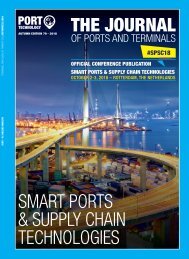Strengthening the Supply Chain
The supply chain is evolving, and the current COVID-19 pandemic is putting it under more pressure than it ever has been before. It is therefore imperative that ports and the entire logistics chain is as efficient and flexible as it can possibly be. One thing that many within the port and maritime industry have agreed upon is that this crisis will accelerate the adoption of new technologies throughout the supply chain. Blockchain for instance has been touted as a key technology that could fix the disconnect that has been revealed because of the COVID-19 crisis, this according to the World Economic Forum. The opportunity for innovation now extends beyond the port and in this e-Journal we explore how rail can play its part in meeting new customer demands, what TradeLens can offer the likes of the mega supply chain in India, and how the Port of Rotterdam leads the way in connecting ports across the globe. In addition, A.P. Moeller-Maersk provides an evaluation of how its Intercontinental Rail Service is providing customers another logistics platform for the movement of freight beyond the port.
The supply chain is evolving, and the current COVID-19 pandemic is putting it under more pressure than it ever has been before.
It is therefore imperative that ports and the entire logistics chain is as efficient and flexible as it can possibly be.
One thing that many within the port and maritime industry have agreed upon is that this crisis will accelerate the adoption of new technologies throughout the supply chain.
Blockchain for instance has been touted as a key technology that could fix the disconnect that has been revealed because of the COVID-19 crisis, this according to the World Economic Forum.
The opportunity for innovation now extends beyond the port and in this e-Journal we explore how rail can play its part in meeting new customer demands, what TradeLens can offer the likes of the mega supply chain in India, and how the Port of Rotterdam leads the way in connecting ports across the globe.
In addition, A.P. Moeller-Maersk provides an evaluation of how its Intercontinental Rail Service is providing customers another logistics platform for the movement of freight beyond the port.
You also want an ePaper? Increase the reach of your titles
YUMPU automatically turns print PDFs into web optimized ePapers that Google loves.
STRENGTHENING<br />
THE SUPPLY CHAIN<br />
information you share—no invoices in<br />
competitors’ hands.<br />
• Flexible in that you can parse out <strong>the</strong><br />
facts and figures you need easily.<br />
• People often incorrectly compare blockchain<br />
to a database, but blockchain is<br />
much more than that. It is a way of allowing<br />
parties in <strong>the</strong> supply chain to work<br />
toge<strong>the</strong>r in a trusted way, it fosters <strong>the</strong><br />
collaboration between teams that need<br />
to be collaborating but are not today.<br />
TRANSPARENCY AND DANGEROUS GOODS<br />
Blockchain’s power is <strong>the</strong> openness and visibility<br />
it enables as a digital ledger where<br />
transactions of various types (i.e not only<br />
monetary) between parties are recorded<br />
and secure. In <strong>the</strong> maritime industry, with<br />
so many parties involved in a single transactional<br />
move of a container, we need to<br />
increase collaboration even at times with<br />
our competitors who are involved in a stage<br />
of <strong>the</strong> cargo movement. Specifically talking<br />
about ports and container terminals, how<br />
can blockchain improve operations?<br />
A good use case for ports and terminals<br />
is <strong>the</strong> need for transparency in complex,<br />
manual, paper-based processes. A good example<br />
is dangerous goods documentation<br />
to focus on efficiency and protecting <strong>the</strong><br />
safety of port workers and cargo.<br />
For example, digitizing complex dangerous<br />
goods documentation with its multiple<br />
information handoffs between participants<br />
– customers, suppliers and infrastructure<br />
owners enables better version control,<br />
traceability, change validation, data integrity<br />
and minimizing re-work to ensure validation<br />
all data points to verify documents<br />
on container contents.<br />
OPPORTUNITIES IN INDIA<br />
India has tremendous opportunities to<br />
grow its interior markets. Digitizing supply<br />
chains and using blockchain represent a<br />
significant way to transform <strong>the</strong> country’s<br />
supply chains to improve efficiencies and<br />
competitive advantage. Leveraging data<br />
from upstream transportation documents<br />
can pave <strong>the</strong> way for better Customs processes,<br />
enabling <strong>the</strong>ir ability to identify risk<br />
profile containers, improved duty collection<br />
and increasing <strong>the</strong> velocity of Customs<br />
clearance of ‘safe’ cargo.<br />
As Indian trade continues to expand,<br />
blockchain will be <strong>the</strong> catalyst for more efficient<br />
processes in both Customs and transportation<br />
infrastructure e.g. crowed ports,<br />
trucking capacity, etc. as identified in research<br />
we did on Indian customs processes.<br />
The Government of India is supporting<br />
digital solutions to improve efficiency<br />
and cost-effectiveness of logistics to grow<br />
India’s business. In <strong>the</strong> current Covid 19<br />
scenario, blockchain is being adopted for<br />
electronic bills of lading solutions and<br />
document exchanges that traditionally<br />
required people to hand over paper documents.<br />
With most workers in some form of<br />
lockdown, this is one challenge that has an<br />
existing digital solution.<br />
In addition, India’s banking sector is progressing<br />
which will facilitate TradeLens in its<br />
continued development of an eBill solution<br />
for complex transactions that currently exist<br />
in international trade.<br />
PROGRESS SINCE LAUNCH<br />
Since TradeLens was launched in December<br />
2018, we have achieved commitments from<br />
five of <strong>the</strong> top six global ocean carriers that<br />
handle over half of <strong>the</strong> global containerized<br />
trade. Additionally, over 100 ports and terminals<br />
are active, publishing and consuming<br />
data from <strong>the</strong> platform daily. Engagements<br />
with 15+ Customs authorities globally have<br />
resulted in improved outcomes such as paperless<br />
Customs clearance pilots for export<br />
processes. We are currently piloting paperless<br />
import Customs clearance processes<br />
and blockchain based document validations<br />
for certificates of origin and halal certificates<br />
for example.<br />
TradeLens will be releasing its eBill of<br />
Lading product. The bill of lading is one of<br />
<strong>the</strong> last documents to be digitized at scale<br />
worldwide, because of <strong>the</strong> legal and o<strong>the</strong>r<br />
peculiarities involved with this document.<br />
Having a truly digital, end-to-end eBill solution<br />
will be ano<strong>the</strong>r step towards a digitized<br />
supply chain.<br />
The inclusion of <strong>the</strong> TradeLens eBill product<br />
allows for all documentation needs to<br />
be captured within a single platform, both<br />
seaway bills and currently straight original<br />
bill of ladings are available on <strong>the</strong> platform.<br />
Combining this digital documentation<br />
with workflow automation across multiple<br />
parties in <strong>the</strong> <strong>Supply</strong> <strong>Chain</strong> will generate<br />
strong efficiencies through an end-to end<br />
paperless trade platform.<br />
We envision tremendous innovation<br />
ahead as <strong>the</strong> TradeLens marketplace will<br />
grant approved third parties to build applications<br />
built on top of <strong>the</strong> TradeLens data sets.<br />
EDITION 97 15




